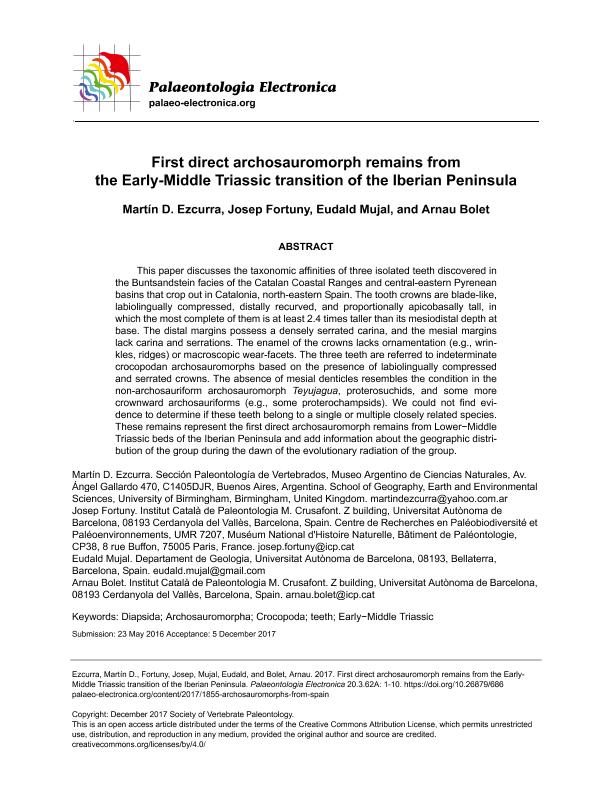Artículo
First direct archosauromorph remains from the early-middle triassic transition of the Iberian Peninsula
Fecha de publicación:
01/2018
Editorial:
Coquina Press
Revista:
Palaeontologia Electronica
ISSN:
1094-8074
e-ISSN:
1532-3056
Idioma:
Inglés
Tipo de recurso:
Artículo publicado
Clasificación temática:
Resumen
This paper discusses the taxonomic affinities of three isolated teeth discovered in the Buntsandstein facies of the Catalan Coastal Ranges and central-eastern Pyrenean basins that crop out in Catalonia, north-eastern Spain. The tooth crowns are blade-like, labiolingually compressed, distally recurved, and proportionally apicobasally tall, in which the most complete of them is at least 2.4 times taller than its mesiodistal depth at base. The distal margins possess a densely serrated carina, and the mesial margins lack carina and serrations. The enamel of the crowns lacks ornamentation (e.g., wrinkles, ridges) or macroscopic wear-facets. The three teeth are referred to indeterminate crocopodan archosauromorphs based on the presence of labiolingually compressed and serrated crowns. The absence of mesial denticles resembles the condition in the non-archosauriform archosauromorph Teyujagua, proterosuchids, and some more crownward archosauriforms (e.g., some proterochampsids). We could not find evidence to determine if these teeth belong to a single or multiple closely related species. These remains represent the first direct archosauromorph remains from Lower-Middle Triassic beds of the Iberian Peninsula and add information about the geographic distribution of the group during the dawn of the evolutionary radiation of the group.
Palabras clave:
Archosauromorpha
,
Crocopoda
,
Diapsida
,
Early-Middle Triassic
,
Teeth
Archivos asociados
Licencia
Identificadores
Colecciones
Articulos(MACNBR)
Articulos de MUSEO ARG.DE CS.NAT "BERNARDINO RIVADAVIA"
Articulos de MUSEO ARG.DE CS.NAT "BERNARDINO RIVADAVIA"
Citación
Ezcurra, Martin Daniel; Fortuny, Josep; Mujal, Eudald; Bolet, Arnau; First direct archosauromorph remains from the early-middle triassic transition of the Iberian Peninsula; Coquina Press; Palaeontologia Electronica; 21; 1; 1-2018; 1-10
Compartir
Altmétricas




